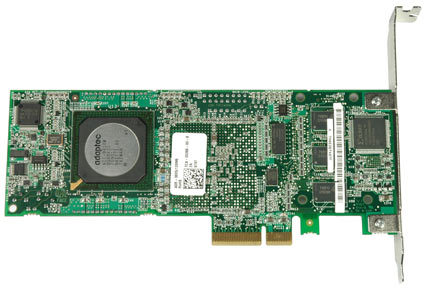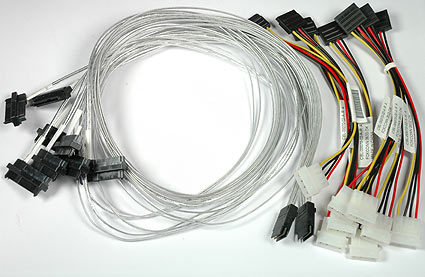Unified Serial RAID Controllers for PCIe
Adaptec RAID 3805
Firmware used: 5.2.0 Build 12415
The first RAID controller card in this roundup is Adaptec’s RAID 3805. The firm differentiates between entry-level, value and performance products, but the model numbering requires some explanation. Every product that begins with a 3, such as this one, is a current unified serial product that supports 3 Gbit/s transfers for SAS and SATA. The second digit determines the total number of drive ports, e.g. eight for the RAID 3805, or 16 for the RAID 31605. If there is a 0 in front of the drive count, the controller is designed for external drive appliances. The last digit can either be a 0 or a 5, where 0 mains host-based RAID and 5 describes hardware-accelerated RAID 5 and RAID 6 support. All unified serial products are PCI Express based; there are no new PCI-X products anymore. Incidentally, don’t confuse the RAID 3805 and RAID 3085, the latter of which is the external card with a faster IOP unit.
The RAID 3805 is a current product with eight SAS ports and hardware-accelerated RAID for PCI Express. It is an entry-level to mid-range product and can be used on a variety of operating systems, including all versions of Windows starting with Windows 2000, Red Hat and SuSe Linux, Novell Netware, SCO Open Server, Sun Solaris, FreeBSD, UnixWare and VMware ESX Server. It runs an Intel 80333 processor at 500 MHz for XOR calculations, and it has 128 MB of DDR2 memory with ECC. Thanks to the low-profile form factor and two SFF 8487 connectors that merge four ports into one physical connection, the RAID 3805 can be deployed into compact 1U rackmount servers that offer an x4 PCI Express slot.
Adaptec supports RAID modes 0, 1, 1E (equals RAID 10), 5, 5EE (with hot spare), 6, 10, 50, 60 and JBOD, which should give administrators quite some flexibility. Feature wise you will notice a pretty long list, including RAID features such as online capacity expansion, RAID level migration, quick/background initialization, native command queuing support (NCQ), variably assignable hot spares (global/dedicated/pooled), enclosure management support via SCSI-accessed Fault-Tolerant Enclosure (SAFTE), staggered drive spin-up, hot plugging, redundant path failover and even more. One interesting feature is support for a so-called "copyback hot spare", which turns the hot spare back into a hot spare once the failed drive has been replaced and reconstructed. This way you don’t have to change the labels on your drive enclosure. Be sure to look at our feature table to compare the three controllers.
The box includes the controller, a low-profile slot bracket, a short installation guide in several languages, a software CD, and two Mini SAS to SATA fanout cables based on the SFF 8487 and SFF 8484 standards. There is an optional battery backup module, which I used to keep cached data alive in case the system loses power. While the company has abandoned its approach of selling its Advanced Data Protection software (RAID 6 support and additional features) as an optional upgrade, snapshot backups will only work if you purchase a registration key. There is a three-year warranty for the RAID controller.
Get Tom's Hardware's best news and in-depth reviews, straight to your inbox.
Current page: Adaptec RAID 3805
Prev Page Drive Trends: 2.5" Moving In Next Page RAID Array Creation
Patrick Schmid was the editor-in-chief for Tom's Hardware from 2005 to 2006. He wrote numerous articles on a wide range of hardware topics, including storage, CPUs, and system builds.
-
Rik ...well,Reply
- Unless RaidCore is trying to peddle their VST Pro software,...aka as Fulcrum proprietary based ? which BTW you said no to, I don't see any advantages here.
Why?, ZFS is free !
And, where are the Drives for Solaris, or the xBSD's , or even MacOSX !!!?
-and still no, becuase their newer 54xx series doesn't support the other 'ix OS's.
Nope, unfortunately, not much to see here.
so, based on the above, Adaptec 5805,... or Areca,... blows this.
-Rikster
-
aapocketz ReplyFor SAS, the two connector segments were merged, which makes it possible to attach a SAS drive to a SATA controller using the continuous connector, but you cannot hook up a SAS hard drive to a SATA controller using the SATA connector (SFF 8482).
I think this paragraph has an error. I believe it should read
For SAS, the two connector segments were merged, which makes it possible to attach a SATA drive to a SAS controller using the continuous connector, but you cannot hook up a SAS hard drive to a SATA controller using the SATA connector (SFF 8482).
In fact I believe the statement should have less emphasis on the connector as its the actual controller that appears to limit the connectivity, the connector is just keyed to allow you to plug SATA drives into SAS but not the other way around.
from wikipedia: "SATA 3.0 Gbit/s drives may be connected to SAS backplanes, but SAS drives may not be connected to SATA backplanes."
I believe the fact that signaling voltages are nearly double on a SAS drive is significant to mention.
Let me know if I am wrong, I just started playing around with a bunch of SAS drives so I am figuring this out as I go.
-
Factors like spindle speed, density, latency etc. effects drive performance as much or more than bandwidth. A 300GB 2.5 15K SAS drive will smoke a 1TB 7200 SATA drive simply because it has about twice the IOPS. The bandwidth is meaningless if you can't get the data on and off the disk at the speed of the bus. Furthermore, except for the WD Velociraptor 10K+ spindle speed drives are non-existent in SATA but are prevalent in SAS. So from an interface standpoint they are very close but SAS drives are really intended for entirely different markets and applications and budgets I might add.Reply
-
Bicom Systems Great article - thanks for the comparison! We also did a piece on SAS and SATA, if you're interested : http://blog.bicomsystems.com/sas-vs-sataReply


